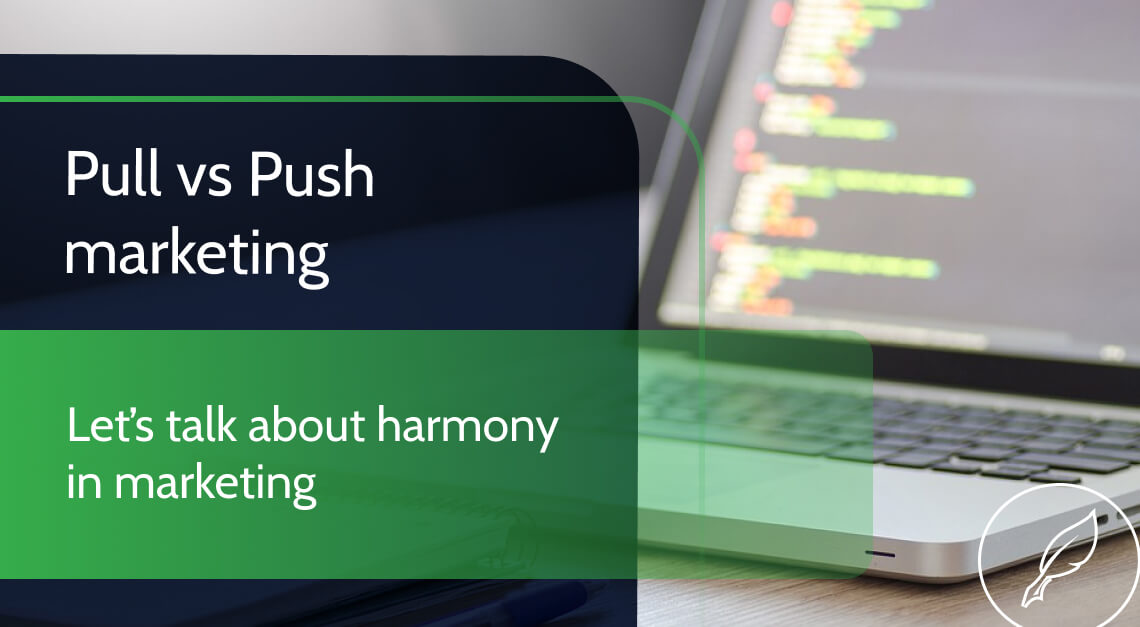Pull vs Push as a marketing ying-yang

We devote the following entry to a specific marketing issue, that is the difference between push and pull strategies. They sound as opposites, don’t they? Are those quite similar? Seek for answer in today’s article.
Pull and Push marketing… what are those?
Marketing is an extremely extensive field – no wonder large number of concepts have been developed to serve one overriding purpose – to advertise a given product to our potential customer. There are many ideas. Some of them even seems to present a completely different approach to the same topic! Pull and push marketing are such duo. Both differ in terms of the way they reach the user and interact with target group. Let us explain the details below.
What does push marketing mean?
Push reflects the specificity of the given concept.
Manufacturers try to ‘’push” or, what is more appropriate, seek for tools that help them present new product to potential customers. Entrepreneurs dream of improving sales and increasing consumer awarness of a brand.
Therefore, these all are activities (sometimes called ‘’invasive”) that introduce something new to somebody. For example, traditional acquisition activities (we mean the seller who visits the homes of potential customers and present their product) or hiring people at stands in large shopping malls (they encourage people to familiarize with the samples).
The solution presented above is certainly a must for new companies that have not established their reputation yet and the consumer awarness of activities carried out by the entrepreneur is low. Remember that it is not the only opportunity to take advantage of – actions taken by large brands include, for instance, a temporary reduction in prices on some products or whole assortment. Push marketing bring profits if we offer a product that customers buy under the influence of a sudden and momentary impulse too.
To sum up, in case of push marketing we state at the perspective of a finished product that must be presented in an attractive way. Of course, there is also an opposite approach, based on proceeding from the perspective of the client needs, as our recipients are looking for a solution to the problem for sure.
What is pull marketing?
If you had read the section above carefully, it would not be difficult for you to find the answer to this question.
Pull marketing attracts new customers to our product, as it is presenting it as a solution to a specific problem, and create a need for it among potential recipients.
The model of sales and customer relations vary too. While push marketing assumes ‘’impulsiveness” of sales and short-term benefits, the idea of pull marketing go along with creation of stable and loyal group of recipients who remain loyal. They make use of our services or buy products regularly.
According to the focus on a ‘’long-distance” results, pull marketing campaigns are costly and resource-intensive. After all, the main goal is to create an ‘’icon” of the brand.
A popular carbon drink is considered to be the best thinkt to drink on hot days. In turn, a fashion brand can be associated with mountain climbing clothing, etc.
Therefore, the assumption is that we gain a reputation even though we spend much money on advertising.
For this reason, the strategy is less accessible to smaller companies or those who have just started operating. It is difficult to build recognition on a name of brand that has not had a chance to appear in the broadly understood consumer consciousness so far.
Pull or push or… both of them?
Although the concepts described above assume a completely different approach to subject, their purpose seems to be the same… and it really is! Therefore, it is possible to use both – bet on a specific mix or use them alternately to increase your chances of success.
Let’s see how it is in practice. Thanks to the push concept, we can create a specific need in the recipients mind. We use different tools and pull marketing to present ourselves as a solution to specific need. The discussed model, although it seems simple, can be effective.
The initial marketing activities should be centered around the push concept. The possibilities, especially in the age of widespread Internet use by potential customers, are really wide.
We arrange such opportunity to arrange customer and product ‘’face to face” meeting, either at advertising stands or organized meetings. If we obtain a database that contain group of recipients, we may send them emails. Social network accounts and paid Internet advertising are effective too.
As soon as we reach a permanent group of recipients, we can start adding elements of pull marketing to our strategy. Encouraging existing customers to rate the products or services is an example as it increase their popularity. Incorporate user generated content is also a solution.
Summary
- We hope that you perceive pull and push marketing as co-operating, not mutually exclusive concepts now.
- After all, the main goal of advertising activities is to sell a specific product or service.
- There are many paths that lead to this. Choosing one does not exclude others, so it is worth keeping in mind when planning next campaigns.

















Leave a Reply